mytest






![]()
UPDATES ON TWITTER: arudoudebito
Hi Blog. Today is the tenth anniversary of our visit, on September 19, 1999, to “Japanese Only” Yunohana Onsen et al in Otaru, a life-changing event that to this day has not been fully resolved — mainly because we still don’t have a law against racial discrimination in Japan. This situation remains more than 13 years after Japan effecting of the UN Convention on the Elimination of Racial Discrimination, where it promised to take “all measures, including legislation” to effectively eliminate all forms of RD. And it deserves comment and reflection after years of protests, two books, countless articles, and successful lawsuits against the onsen (albeit not against the negligent City of Otaru).
I wrote this article by invitation for the Japonesia Review last January and submitted it in February. After more than seven months’ wait, I see no reason not to publish it here in advance on Debito.org on this auspicious occasion. Written in a simpler style for a non-native audience, there are some anachronisms within (such as regarding FRANCA’s founding). Enjoy.
My thoughts on this day are bittersweet. I know we did the right thing (as Olaf noted, when I called him today, people are still talking about the case), and we had a good outcome in court. But I judge things like this based upon whether or not they could ever happen again. The answer is, unfortunately, yes. After all, all Yunohana Onsen has to do is put up another “Japanese Only” sign and we’d have to take them to court all over again just to get it down. There is no law to stop it, nothing for authorities to enforce. Ten years later, it feels more overdue now than in 1999.
Arudou Debito in Sapporo
ARTICLE BEGINS:
======================================
THE OTARU ONSENS LAWSUIT: TEN YEARS ON
What has and has not changed regarding human rights for Non-Japanese in Japan.
ARUDOU DEBITO
Photo Caption: The author in front of Yunohana Onsen, Otaru.
(Photo courtesy Shouya Grigg of Kookan.com)
For publication in Japonesia Review 2009, Submitted February 3, 2009 and still not published.
DRAFT ONE
PREFACE: BACKGROUND ON THE OTARU ONSENS CASE
On September 19, 1999, a group of seventeen people went to take a bath at a “super sento” (public bathhouse) named Yunohana Onsen (www.yunohana.org) in Otaru, Hokkaido. All seventeen were Japanese, except for three Caucasian males (including the author) from America and Germany, and one Chinese woman from Shanghai. She, like the non-Japanese (NJ) men, was married to a Japanese and came to Yunohana as an international family. We had heard over the Internet that Yunohana, Otaru’s largest bathhouse, was not only refusing entry to NJ, they were even openly displaying a “JAPANESE ONLY” sign on their front door in three languages (Japanese, English, and Russian).
Caption: Yunohana Onsen’s exclusionary sign, 1999
As soon as everyone had entered and bought tickets, we were told that the three Caucasian males in our group (your author included) were not allowed inside.
Consulting with the manager on duty, we heard Yunohana’s justification: Russian sailors (who at the time were frequent visitors to and traders with Otaru) had a history of not following bathhouse rules, therefore were not allowed in because they might cause trouble and inconvenience Japanese customers. When we made it clear that we were neither Russian sailors nor troublemakers, Yunohana said it did not matter: “Refusing only Russians would be discrimination. So we refuse all foreigners equally.”
All foreigners? All. “How about our Chinese friend you allowed in?” As soon as they realized their mistake, management showed her the door. We asked them further about their criteria for determining who was “Japanese”, since it was clear by this example that it was whether somebody looked “Asian” enough. So my wife at the time asked about our daughters, both of whom were born and raised in Japan, spoke Japanese as their first language, and have Japanese citizenship.
One looks more Asian, with black hair and brown eyes, while one looks more Western, with brown hair and bluish eyes. How would they be treated under Yunohana’s rules?
“The Japanese-looking one can come in. But the younger one who looks like a gaijin will be refused entry.”
This made it clear to everyone, nationwide, that “Japanese Only” signs and rules would affect Japanese citizens too.
TEN YEARS LATER: WHAT HAS CHANGED?
If you want to know more about what happened next in the Otaru Case, please read (in English or Japanese) Arudou Debito, “JAPANESE ONLY” — The Otaru Hot Springs Case and Racial Discrimination in Japan[1] (Akashi Shoten Inc, 2003 and 2004, both books revised 2006). The books describe the worldwide debate on the issue; the months of extralegal efforts made to get “Japanese Only” signs down at Yunohana, at other onsens, in other business sectors, and in other cities around Japan; and the successful lawsuit filed against Yunohana Onsen and the City of Otaru that went all the way up to the Supreme Court.
September 19, 2009 marks ten years since we visited Yunohana. Here is a survey of how things have changed, or not changed, in the past decade regarding human rights for NJ in Japan:
1) A spread of “Japanese Only” signs and rules around Japan.[2]
A website devoted to businesses with exclusionary signs and rules called “The Rogues’ Gallery” (www.debito.org/roguesgallery.html), coordinated by the author, has collected photographic evidence on over 150 places, in 29 cities and towns across Japan, with “Japanese Only” signs and rules. Some places (such as Yuransen bathhouse in Wakkanai, Hokkaido, and bars in Misawa, Aomori Prefecture) directly copied the very substance and style of Otaru’s “Japanese Only” signs.
Bathhouse “Osupa”, Otaru, 2000. Hands holding up newspaper substantiating the date are the author’s.
Bar “Globe”, Misawa, Aomori Prefecture, 2002. Note capital “J”, small “o”, font style of “a”, and “y” with a tail.
The language of “Japanese Only” has clearly become established as a “meme” (learned cultural behavior), as a concise and comprehensive way of saying “stay out” to undesirable customers — who just happen to lack (or look like they lack) Japanese citizenship.[AD1]
Hotel “Tsubakuro”, Hyakunincho, Shinjuku-ku, Tokyo, 2003.
Internet café “Dragon BOZ”, Okazaki, Aichi Prefecture, 2006.
B-Ball billiards hall, Uruma, Okinawa, 2006
Bar “Santa Monica”, Kurashiki, Okayama Prefecture 2004. Manager confirming author’s Japanese passport before telling him to leave the premises, as the bar is “Japanese Only”.
Cause: Despite signing the United Nations (UN) Convention on the Elimination of Racial Discrimination (CERD) in 1995 (effected 1996), and despite Article 14 of the Japanese Constitution banning discrimination by “race, creed, sex, social status, or family origin”, Japan still has no law against discrimination by race. This means that if a “Japanese Only” sign goes up, there is no law in the Civil or Criminal Code for police or authorities to enforce, demanding that signs come down and rules change. To the present day, as in 1999, there are no legal means, outside of a courtroom, for people who are discriminated against to stop it.
Effect: If there are no means to stop this kind of discrimination, it spreads, because it is a “quick fix”. It is convenient for vigilantes (who dislike, fear, or do not want to be bothered with NJ) to put a sign barring them. A “Japanese Only” sign up in public lends legitimacy to the exclusion, and encourages copycatting. Numerous interviews carried out by the author of exclusionary establishments have demonstrated a theme of, “We’re not the only ones with the sign up, so why pick on us?” Like any “tipping point”, enough occurrences can lead to a threshold where isolated instances become legitimized by numbers and precedent, leading to an established practice. That is how discrimination spreads: strength in numbers.
2) The rubric of “Japanese Only” is still based upon physical appearance.
The author of this essay is a naturalized Japanese citizen. However, as the reader can see from his photo at the very beginning, a change of passport has not led to a change from Caucasian to Asian. In the majority of interviews I have had with exclusionary businesses, they have said that even after seeing proof of my Japanese citizenship (my passport or driver license), I would still be excluded from the premises. “You don’t look Japanese. It’ll cause misunderstandings,” was the standard reason.
Cause: Japan still makes a strong association with face/race and nationality, i.e. Japanese people look “Japanese”. Indubitably part of the reason is that Japanese society and media have had limited exposure to “non-Asian Japanese”, such as soccer star Ramos Rui, tarento Konda Bobbi (ne Bobby Ologun), and Dietmember Tsurunen Marutei, to name but a few. There has, however, been copious exposure to international Japanese children Miyazawa Rie, Umemiya Anna, Rebecca Eri RayVaughan (aka “Bekkii”), and also to naturalized citizens with more Asian faces like sumo wrestlers Konishiki and Akebono. However, it is unclear that the public eye has done a complete connect between “Japanese citizenship through roots” and “Japanese citizenship by legal application”, which would mean that “Japaneseness is a legal status”, not a blood status. Reinforcing this disconnect are Japan’s nationality laws, currently under consideration for revision, which explicitly say that Japanese status is something inherited. The laws are jus sanguinis, meaning you must have a Japanese blood relative in order to automatically get Japanese citizenship.
Effect: Many Japanese citizens who do not “look Japanese” will be treated as NJ — not only this author, but also many hundreds of thousands of children of international marriages. Japan’s international marriages are currently about 40,000 per year, up substantially from about 30,000 in 2000, and the number of “mixed children” born annually to be about 21,000[3]. Like the “tipping point” mentioned above that encourages the spread of “Japanese Only” signs, I anticipate that there will be a similar “tipping point” where people realize that racial admixtures are still Japanese. “Conditional Japanese” (as in “half”, “quarter”, “double”, “mix”) have been in the lexicon for quite some time. I think the qualifiers will fade as the numbers increase. Accepting naturalized “non-blood Japanese” will take longer. However, without laws against racial discrimination, one’s face will still not save many “people of mixture” from capricious or ignorant treatment as apparent NJ.
3) “Monocultural, monoethnic Japan” is officially no longer.
Japan’s public policy is also surprisingly exclusionary. Postwar Japan has had public speech at the highest levels (most famously former Prime Minister Nakasone in 1986) extolling “ethnic homogeneity” and “racial purity” as a strength. The Japanese government has repeatedly reported to the UN that the CERD treaty was not applicable to Japan. Japan apparently has no racial minorities (moreover that all people who were in fact racially different were not citizens, therefore also not covered)[4]. This is reinforced in public policymaking. When one reads white papers and laws, the rubric is that the policy is for the benefit of “citizens” (kokumin)[5], as opposed to “taxpayers” (nouzeisha) or “residents” (juumin). Thanks to the vagaries of the Residency Certificate (juuminhyou) system[6], NJ are still not officially listed or counted as “juumin“. Local governments (such as Tokyo Nerima-ku[7]) also do not include NJ in their tally of “residents”. Nor does the National Census (kokusei chousa) survey residents for ethnicity (minzoku) — only nationality (kokuseki). Nor does the Ministry of Health always include NJ (or even newly-naturalized citizens) in its tally of population growth or shrinkage: preferring to use a simple calculation of “births minus deaths”[8].
That said, in June 6, 2008, the Diet for the first time unanimously passed a resolution stating that the Ainu aboriginal people of Hokkaido were a “indigenous people with a distinct language, religion, and culture”. For the first time, Japan’s government did not ignore an ethnic minority in its public policy, and in fact had set up a government panel to study remedial actions.
Cause: It was good timing. As was discussed in this forum (Ota Masakuni, Japonesia Review No. 5, 2008), both the confluence of a UN Human Rights Council Universal Periodic Review on Japan in May, and the Hokkaido G8 Summit (where Hokkaido minority issues were gaining attention and traction) in July that same year, contributed to a push the Fukuda Administration to offer this showcase for human rights. A multi-partisan “Concerned Diet Members’ Group for the Rights of the Ainu” spearheaded the drive.
Effect: On September 28, 2008, new Transport Minister Nakayama Nariaki resigned over various gaffes (including calling Nikkyouso schoolteacher union “a cancer”) that reflected older-school thinking: Speaking on behalf of Japan’s new tourism agency, he mentioned that Japan was “ethnically homogeneous” and in general “Japanese don’t like foreigners”. He was roundly criticized, notably by Social Democratic Party leader Fukushima Mizuho, who said, “Is he ignorant of a Diet resolution which all the members (of both houses of the Diet) supported?”[9] Thus began an ignominious start to the 2008 Aso Cabinet, which helped set the tone for the rest of his unpopular administration. This is the first time a resignation has resulted from a “homogeneous” remark, a far cry from the days of Nakasone.
That said, Ota notes that without a supplemental change in historical perspective in the Japanese public, the consequences for Ainu and other (unrecognized) minority rights may be “inconclusive” (the abovementioned government panel, after all, only has one Ainu member). Similarly, it is probably too early to draw conclusions or show undue pessimism at this time. Wait and see.
4) Japan’s economics and demographics are making immigration inevitable.
Japan is still the second-largest economy by GDP and by most measures larger than all other Asian economies combined. The current worldwide economic downturn notwithstanding, Japan has for three decades had a labor shortage. The government recognized this in 1990 and, at the behest of the industrial lobby, inaugurated a backdoor “Trainee”, “Researcher”, and “Returnee” (teijuusha for overseas Nikkei) working visa program. This regime brought over millions of cheap Asian and South American laborers, more than doubled the NJ population of 1990 from one million to two, and fundamentally shifted the top three NJ ethnicities from 1) Korea (North and South), 2) China, and 3) The Philippines[10] to 1) China, 2) Korea, and 3) Brazil. Industrial towns in Shizuoka, Gifu, and Aichi Prefectures showed NJ population percentages in the double digits, and for the first time mayors of these towns were demanding the national government secure equal rights and enhanced access to social services for their NJ residents[11]. NJ were coming to Japan, being welcomed, and put to work.
They were filling a gap. Thanks to the low birthrate and long life expectancies of the Japanese public, the UN and the Obuchi Administration in 2000 jointly recognized that the Japanese population was aging, and would decrease by the late 2000s if Japan did not import 600,000 NJ per annum[12]. Japan has, on average this decade, imported a net total of 50,000 NJ per annum. Sure enough, by 2007, Japan’s population was first officially announced as dropping. If trends continue, by 2050, according to Shuukan Ekonomisuto (January 15, 2008, pg 16), the percentage of Japanese over retirement age (65) is projected to be more than half of the entire population. Who will man the factories, pay in taxes, and maintain social security pension payments? NJ keep Japanese society young and the birthrate from falling further. The government is currently deliberating scrapping the current backdoor-labor visa regime, and establishing an official immigration policy.
EPILOGUE: TEN YEARS LATER, WHAT HAPPENED IN THE OTARU ONSENS CASE?
The author and two other plaintiffs sued both Yunohana Onsen and the City of Otaru for racial discrimination and negligence under the CERD. Yunohana lost both in Sapporo District and High Court, and was ordered to pay plaintiffs one million yen each for “unrational discrimination”. The City of Otaru won in Sapporo District Court, High Court, and the Supreme Court; the District and High Courts grounded their arguments in “separation of powers” arguments (as in, the judiciary cannot force a government body to pass laws against discrimination, and cannot hold one accountable for not doing so). The Supreme Court ruled that this contravention of Article 14 was “not a Constitutional issue”[13].
Yunohana Onsen took their “Japanese Only” sign down shortly before the lawsuit began, but never apologized for its action. It took advantage of the publicity from the lawsuit to open new branches. Yunohana is now a chain with outlets in Otaru Temiya, Otaru Asari, Sapporo Jozankei, and Ebetsu. Other places and business sectors around Hokkaido and Japan still have their “Japanese Only” signs up.
The Japanese government made it clear to the UN again in March 2008 that it has no intention of creating a law against racial discrimination, reiterating that it has an active judiciary for grievances, therefore no laws are necessary. It stressed in the indicatively-named “Third, fourth, fifth, and sixth combined periodic report to the UN HRC”[14] that it had taken “every conceivable measure to fight against racial discrimination” (begging the question why passing a law is “inconceivable”). Several draft bills have been submitted to the Diet and to the Otaru City Government, but all have died in deliberation.
Author and plaintiff Arudou Debito still works as a university educator at Hokkaido Information University in Ebetsu. Author of two books on the Otaru Onsens Case, Arudou, 44, has recently co-authored another book to help NJ make more secure lives in Japan: Handbook for Newcomers, Migrants, and Immigrants to Japan (Akashi Shoten Inc. 2008, English and Japanese). He also is setting up an NPO called FRANCA[15] to better lobby for rights of NJ in the political sphere. He sees the Ebetsu branch of Yunohana every day on his drive to work.
ENDS
2600 WORDS
[1] www.debito.org/japaneseonly.html
[2] More information on this in Japanese in「『外国人』入店禁止という人種差別」(有道 出人 著)、単行本『日本の民族差別 人種差別撤廃条約からみた課題)』p218ー229、岡本雅享先生監修・編著、明石書店(株)2005年6月出版
[3] “Japanese youth help compatriots embrace diversity”, Christian Science Monitor, January 18, 2008, www.debito.org/?p=933
[4] The text of the debate between Japan and the United Nations may be found at www.debito.org/japanvsun.html
[5] See example at “Forensic Science Fiction: Bad science and racism underpin police policy.” Japan Times, January 13, 2004, at www.debito.org/japantimes011304.html, particularly sidebar at bottom.
[6] www.debito.org/activistspage.html#juuminhyou
[8] “Japan sees biggest population fall”, Associated Press, printed in the Manchester Guardian, January 2, 2009, www.debito.org/?p=2117
[9] www.debito.org/index.php/?s=Ainu+resolution+June
[10] www.stat.go.jp/data/chouki/02.htm
[11] See for example the Hamamatsu Sengen at www.debito.org/hamamatsusengen.html
[12] Arudou, Debito, “The Coming Internationalization: Can Japan assimilate its immigrants”. Japan Focus, January 12, 2006, www.japanfocus.org/products/details/2078
[13] www.debito.org/otarulawsuit.html
[AD1]To Hikaru: Play with the layout and put these signs around the article as you like. More at www.debito.org/roguesgallery.html
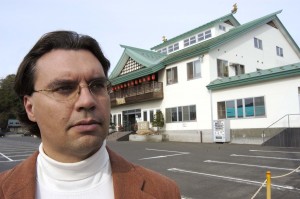
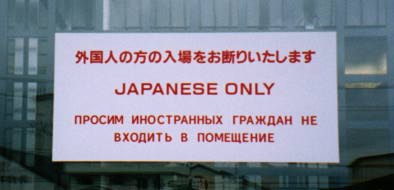
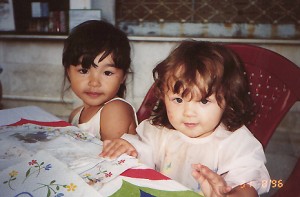
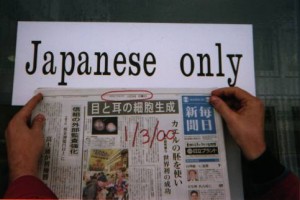
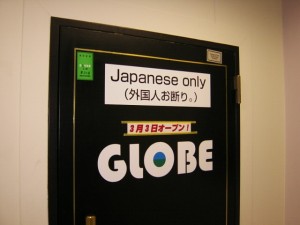
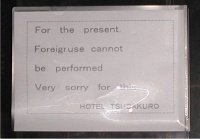
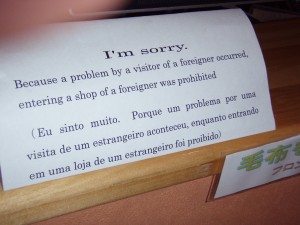
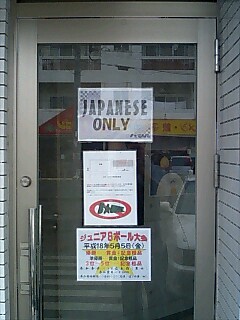
8 comments on “THE OTARU ONSENS LAWSUIT, TEN YEARS ON: Article for Japonesia Review”
Debito,
I think no matter what the outcome has been, you deserve a thank you on behalf of all of us who have the similar concerns about our daily lives in Japan. If it were not for your efforts in creating awareness … then who knows. You have made an impact! Not only on formal institutions, but on J and NJ people!
Thank you
Peach
its been 10 years already, and i cant believe that the GOJ has not passes a racial discrimination law yet? how could they even ask for a seat on the UN security council until they clean up there own government first. korea has once again beaten japan to the punch, because they already passed there own law two years ago. and japan is suppose to be the so-called leader in asia, i dont think so.
hopefully in the next 10 years japan will really make some radical changes in there government and mindset for the future of (ALL) citizens of japan.
Debito, it’s bound to happen again. The question is whether there are effective penalties in place to discourage discrimination, and effective remedies for those who have been victimized.
— There are not.
I agree 1 thousand percent with Peach. Thanks for all your untiring efforts on our behalfs!
I went to this onsen in 2011 and I didn’t even know about this case. They had no problems admitting me.
— Good.